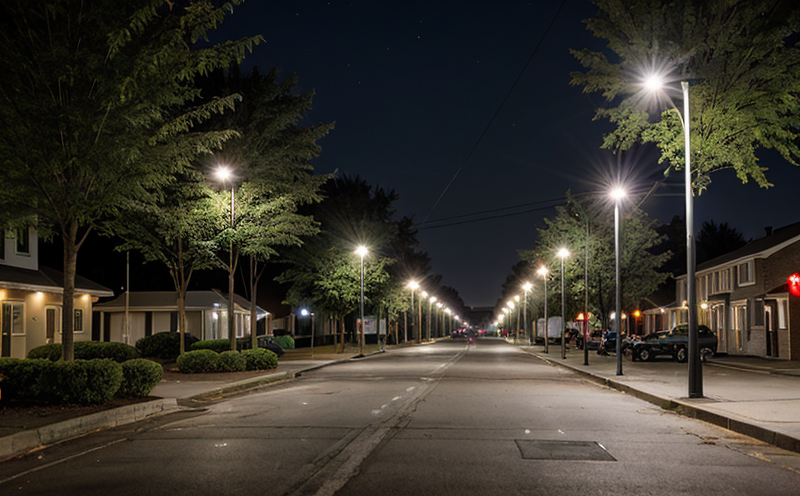CIE 115 Outdoor Road Lighting Testing of Lighting Quality Parameters
The International Commission on Illumination (CIE) Standard CIE 115 is a comprehensive guideline for the testing and evaluation of outdoor road lighting systems. This standard ensures that the lighting quality parameters meet specified requirements, thereby enhancing safety, visibility, and comfort for pedestrians and drivers alike.
The primary focus of CIE 115 lies in assessing several critical parameters that impact the overall performance of road lighting installations:
- Uniformity: The distribution of light intensity across a given area must be consistent to avoid hotspots or dark patches on roads. This ensures even illumination, which is crucial for safe driving and walking.
- Glare: Excessive glare can cause discomfort and distraction, leading to accidents. CIE 115 provides methods to measure and mitigate glare from lighting fixtures.
- Color Rendering Index (CRI): The ability of a light source to accurately render colors is important for distinguishing objects clearly at night. High CRI values ensure that traffic signals and road markings are easily recognizable.
- Light Loss Factor: This parameter accounts for the expected decrease in luminance over time due to aging, dirt accumulation, or other factors. Ensuring compliance with this factor helps maintain long-term performance reliability.
- Luminous Intensity Distribution: The angular distribution of light emitted by a source is vital for achieving optimal lighting levels at different distances from the fixtures.
- Color Temperature: The perceived warmth or coolness of a light source affects its acceptability and usability. CIE 115 helps specify acceptable ranges based on local conditions.
- Light Output: Measuring the total amount of visible light emitted by a lighting system ensures it meets specified brightness requirements.
- Luminous Flux: The total quantity of light emitted in all directions is another key metric for evaluating overall efficiency and performance.
To perform these tests according to CIE 115, specialized equipment such as photometers, goniophotometers, and spectrophotometers are employed. Specimen preparation involves setting up the lighting fixture in a controlled environment that simulates real-world conditions, including ambient temperature variations and humidity levels.
Compliance with CIE 115 is essential for ensuring that road lighting systems meet international standards, thereby enhancing public safety and reducing maintenance costs. Non-compliance can lead to accidents, legal liabilities, and reputational damage.
Why It Matters
The implementation of CIE 115 Testing is critical for several reasons:
- Safety: Properly tested road lighting ensures that drivers and pedestrians have sufficient visibility, reducing the risk of accidents.
- Efficiency: By optimizing light distribution and minimizing glare, CIE 115 helps achieve maximum energy efficiency without compromising on safety or comfort.
- Compliance: Meeting international standards is crucial for regulatory compliance and avoiding costly penalties.
- Risk Management: Ensuring that lighting fixtures meet specified criteria reduces the likelihood of malfunctions, which could lead to incidents.
- User Satisfaction: Well-designed and tested road lighting contributes positively to community well-being by providing a pleasant environment for all users.
- Longevity: Regular testing helps identify potential issues early on, allowing for timely maintenance and extending the lifespan of fixtures.
In summary, CIE 115 Testing is not just about meeting regulatory requirements; it’s about creating safer, more efficient, and more user-friendly road lighting systems. This ensures that both infrastructure providers and end-users benefit from reliable and effective solutions.
Quality and Reliability Assurance
Ensuring the quality and reliability of outdoor road lighting through CIE 115 Testing involves several key steps:
- Preparation: The lighting fixtures are set up in a controlled environment that replicates real-world conditions. This includes adjusting for environmental factors such as temperature, humidity, and wind speed.
- Data Collection: Using advanced instrumentation like photometers and goniophotometers, detailed data on light distribution, intensity, color, and other parameters are collected.
- Analysis: The gathered data is analyzed against the specified criteria outlined in CIE 115. Any deviations from these standards are noted for further investigation or corrective actions.
- Reporting: A comprehensive report summarizing all test results and compliance with standards is prepared. This document serves as evidence of adherence to international best practices.
The rigorous nature of CIE 115 Testing ensures that any lighting system installed meets the highest quality and reliability standards. Regular testing throughout the lifecycle of a project guarantees ongoing performance and longevity, contributing significantly to overall infrastructure sustainability.
Competitive Advantage and Market Impact
Compliance with CIE 115 Testing can provide significant competitive advantages in both domestic and international markets:
- Brand Reputation: A proven commitment to quality and safety enhances brand reputation, making your products more attractive to potential customers.
- Market Access: Meeting international standards opens doors to global markets where local regulations are stringent.
- Demand Generation: Demonstrating compliance with recognized standards can generate higher demand for your products due to increased trust and reliability among consumers.
- Cost Efficiency: By identifying and addressing potential issues early in the development process, you reduce costly rework and maintenance later on.
- Innovation: Adherence to high-quality testing standards encourages continuous improvement and innovation within your organization.
- Sustainability: Ensuring long-term performance and reliability through rigorous testing aligns with broader sustainability goals, appealing to environmentally conscious consumers.
Overall, CIE 115 Testing is a strategic investment that can drive business growth and market success. It helps your organization stand out in the competitive landscape by offering products and services that are not only reliable but also exceed customer expectations.





